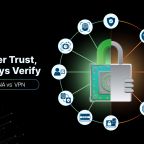Can You Reduce Infrastructure Costs While Enhancing Cybersecurity? ZTNA and Hybrid Cloud Might Be the Answer
Overview
In this comprehensive guide, we explore strategies to reduce IT infrastructure costs while enhancing cybersecurity. Learn how transitioning from legacy solutions like Citrix and traditional VPNs to modern alternatives such as Zero Trust Network Access (ZTNA) and hybrid cloud can lead to significant cost savings and improved security.
IT cost reduction involves eliminating waste and low-value activities in IT departments. Strategies include immediate budget relief and long-term financial benefits without compromising cybersecurity.
This guide helps you create a roadmap for optimizing IT investments while improving cybersecurity. Transitioning from traditional virtualization solutions like Citrix to modern, flexible alternatives, and replacing legacy VPNs with ZTNA tools aligned with a Secure Access Service Edge (SASE) strategy, achieves both cost-efficiency and robust security.
10 Rules for Rapid IT Cost Reduction
- Focus on Cash Impact: Target items with real cash impact, such as savings in SaaS or IaaS costs.
- Target Immediate Impact: Prioritize expenses that will have an immediate impact within the year, like monthly SaaS costs.
- Reduce, Don’t Just Freeze: Aim to truly reduce or eliminate costs, not just freeze them temporarily.
- Plan to Do It Once: Make deep cuts initially to avoid repeated reductions, which can harm productivity and morale.
- Inspect Accounts Carefully: Obtain a detailed view of expense accounts to identify specific cash reductions.
- Target Unspent and Uncommitted Expenses: Look for rapid savings in unspent or uncommitted expenses and renegotiate contracts.
- Be Holistic, Include Capex: Include capex reductions by consolidating data center assets or extending equipment lifespan.
- Ignore Sunk Costs: Focus on future payments relative to their potential benefits rather than past expenditures.
- Address Discretionary and Nondiscretionary Spend: Differentiate between run costs and grow-and-transform initiatives to find reduction opportunities without compromising core operations.
- Tackle Variable and Fixed Costs: Eliminate fixed costs where possible and manage consumption to reduce variable costs.
Leveraging Hybrid Cloud for Optimal Performance and Cost Savings
Identifying Workflows for Public Cloud Migration:
Assess workflows to determine which can be securely migrated to the public cloud. High-performance computing tasks, VDI, intranet web applications, and virtualized desktop or client-server applications are ideal candidates.
Secure Migration Strategies:
Ensure secure migration by using encryption, robust access controls, and continuous monitoring. Implementing ZTNA can provide additional security by authenticating and authorizing users.
Controlling Public Cloud Costs with Automation:
Use automation tools to monitor usage and optimize resource allocation. Automated scaling, cost management dashboards, and usage alerts help control cloud expenses, ensuring you pay only for what you use.
Retaining Critical Workflows On-Premises:
Certain workflows may need to remain on-premises due to compliance, latency, or security requirements. Modern, flexible virtualization tools can avoid high renewal costs from legacy solutions like Citrix or VMware. Evaluate client and clientless ZTNA tools to enhance cybersecurity for on-premises deployments.
Implement ZTNA & PAM on the Entire Hybrid Cloud
Zero Trust Network Access (ZTNA):
ZTNA operates on the principle of “never trust, always verify,” continuously authenticating users and devices before granting access. This minimizes unauthorized access and reduces the need for complex VPN infrastructure.
Privileged Access Management (PAM):
Implementing PAM helps secure and monitor privileged accounts, reducing the risk of insider threats. Enforcing least privilege and robust authentication measures safeguard critical systems from unauthorized access.
How Thinfinity Can Help
Thinfinity offers solutions tailored to these challenges. Thinfinity’s modern virtualization platform provides flexible, scalable alternatives to traditional solutions like Citrix, avoiding vendor lock-in and reducing costs.
Seamless ZTNA Implementation: Thinfinity’s secure remote access capabilities facilitate the implementation of ZTNA, ensuring continuous authentication and authorization.
Hybrid Cloud Support: Thinfinity supports hybrid cloud deployments, allowing you to migrate suitable workflows to the public cloud while retaining critical applications on-premises.
Automation Tools: Thinfinity VDI Manager automates VDI auto-scaling and application provisioning based on usage, time schedules, and more on any public cloud (Azure, AWS, GCP, Ionos, Oracle), keeping cloud costs under control.
Enhanced Security with PAM: Thinfinity’s PAM solutions ensure privileged accounts are strictly controlled and monitored, mitigating the risk of insider threats.
Conclusion
In today’s digital landscape, cybersecurity and cost optimization must go hand in hand. By adopting a holistic cybersecurity strategy that encompasses ZTNA, virtualization, and PAM, organizations can maximize IT investments while enhancing security.
- Transitioning from traditional remote access solutions to ZTNA improves security posture and offers significant cost savings.
- Virtualization optimizes resources and facilitates efficient threat analysis and recovery.
- PAM ensures rigorous control and monitoring of privileged accounts, mitigating insider threats and ensuring compliance with security standards.
Adhering to the ten rules for rapid IT cost reduction provides a roadmap for optimizing IT expenditure while enhancing operational efficiency and security. The successful implementation of this holistic approach, evidenced by real-world case studies, highlights the potential to protect digital assets, fuel growth, and achieve long-term success. Embracing the synergies of ZTNA, virtualization, and PAM allows organizations to navigate the complexities of modern IT infrastructure with confidence and resilience, securing their future in an ever-evolving global market.
Maximize IT Efficiency with Advanced Cybersecurity
Discover how integrating ZTNA and hybrid cloud can revolutionize your IT infrastructure, enhancing security while reducing costs. Our comprehensive guide outlines practical strategies and solutions tailored to your business needs.
Reduce IT Costs & Enhance Cybersecurity with ZTNA and Hybrid Cloud
Learn how our comprehensive guide explores strategies to reduce IT infrastructure costs while enhancing cybersecurity through modern alternatives like Zero Trust Network Access (ZTNA) and hybrid cloud. Discover how transitioning from legacy solutions can lead to significant savings and improved security.




